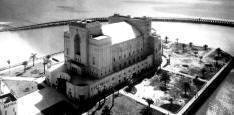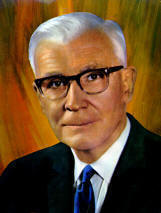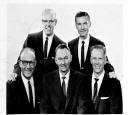|
A grim faced Rudy Alber walked
purposefully into the small office in Pasadena on a late August day in 1937.
He wished he were somewhere else. For years he had built his R.H.Alber
Agency by successfully representing his clients with the radio networks. Now
he had failed and would have to say good-bye to a client who had become a
personal friend.
Charles Fuller looked up as Alber entered his office. Fuller was a large
man, six feet tall with a size twelve double E shoe and a full head of hair
gray appropriate for his fifty years. Even before Alber spoke, Fuller knew
the news was bad.
"It's all over Charlie. A national tobacco company has told Mutual that
they're ready to sign a coast-to-coast contract for your time slot beginning
the first Sunday in October."
The news was devastating. Since 1929 the Reverend Charles E. Fuller had used
radio to expand his preaching ministry. For several years he experimented
with varying program formats on local Southern California stations. In 1935
his Heart-to-Heart/Radio Revival Hour program could be heard in several
states over powerful KNX in Hollywood. On January 10, 1937, Fuller's long
standing dream of a network radio broadcast approached reality as he signed
a contract with the fledgling Mutual Broadcasting System for a thirteen
station hookup that would carry his Old Fashioned Revival Hour from San
Francisco to Gary, Indiana.
Fuller, who had quit a lucrative position as manager of an orange packing
house to become a pastor, had a plan. As soon as listener support surpassed
current expenses, he would add another station, until one by one his program
was carried coast-to-coast on every Mutual radio station.
But now the dream was over. Shattered.
Charles Fuller gazed out the window in silence. Then he turned to his friend
and radio agent and said, "You tell the Mutual Broadcasting System that the
Old Fashioned Revival Hour will take the network coast-to-coast." Alber was
stunned. "Can you cut it, Charlie?" "No," Fuller replied, "But God can."
The cost was staggering at a time when the country was in the midst of a
depression. From $1,441 per week for thirteen stations to $4,500 for fifty.
The money was due in full the Friday prior to the next Sunday's broadcast.
He didn't have a nickel in reserve and only five weeks to tell his current
audience of the need. Fuller had no denominational or institutional support,
only the nickels, dimes and dollars of loyal listeners.
Recalling that event several years later, Fuller declared, "I'll never
forget that day as long as I live. When we came up to the first Friday
before the first Sunday in October, we not only had the $4,500 to put down,
but we had $4.29 left over. We weren't broke, but we were badly bent!"
Fuller continued on the Mutual network until the fall of 1944. At one point
during the war years, he was carried on more than 1,000 stations at a cost
of $3,500 a week. Stations around the world carried delayed broadcasts of
the program on sixteen inch broadcast transcriptions.
But Fuller's success did not go unnoticed. The Federal Council of Churches
had long opposed paid religious broadcasts. Their pressure on NBC and CBS
had resulted in long standing policies permitting only sustaining broadcasts
of religious programs approved by the Federal Council of Churches and
representing the three major religious groups: Judaism, Roman Catholicism
and Protestantism.
In 1944 the Mutual network succumbed to the increasing pressure and Charles
Fuller's Old Fashioned Revival Hour was dropped. But Fuller was not about to
quit. The R. H. Alber Agency negotiated with hundreds of independent
stations and the program continued on sixteen inch transcription. It meant
the loss of key metropolitan stations and of a coordinated schedule, but his
listening audience soon adjusted.
In the spring of 1949, the fledgling ABC radio network invited the Old
Fashioned Revival Hour to join its programming schedule. During this period
the program continued to add international stations. During the Christmas of
1950, a special Chinese version was produced by Cinemart Sound Studios in
New York, using the Old Fashioned Revival Hour musicians singing in English
but with all of the speaking done by Chinese nationals. In the early 40's
Fuller had tried producing a special Spanish version of the Old Fashioned
Revival Hour directed at South America. But it only lasted a few weeks.
In the fall of 1950, Fuller began a weekly half hour television broadcast
entitled the Old Fashioned Meeting on the ABC television network. If
successful, Fuller intended to turn this ministry over to his twenty five
year old son Daniel, who was completing his studies at the newly founded
Fuller Theological Seminary in Pasadena. However, the program never broke
even and was discontinued after 26 weeks. His son Dan went on to earn two
doctorates and established himself as a respected theologian.
In 1958, radio's decline caught up with the Old Fashioned Revival Hour.
Responding to falling income and a desire on ABC's part to eliminate hour
long programs, the Old Fashioned Revival Hour was cut to a half hour
broadcast, moved to a studio, eliminating both the live audience and the
male quartet. Grace Fuller died of cancer in 1965. As Charles Fuller's
health deteriorated, his son Dan took over the administrative
responsibilities for the broadcast and Fuller Theological Seminary President
David Hubbard became the regular speaker. Charles Fuller died March 18,
1968. The last broadcast of the Old Fashioned Revival Hour was the final
Sunday December 29, 1968.
Fuller's Old Fashioned Revival Hour was a success by any standard of
measurement. During its peak years in the 1940's and 50's, an estimated
twenty million people listened every week. Thousands of letters received
each week told of people who listened in brothels, gambling dens, cocktail
lounges and prisons. People who wouldn't dream of opening their doors to a
local pastor or priest couldn't wait for another broadcast of the Old
Fashioned Revival Hour.
Fuller's particular vision was for those in what he called the "lonely, far
off places." As he stepped before the microphone at the Municipal Auditorium
in Long Beach, California, in his mind's eye he saw only individuals -- a
lonely grandmother knitting in her living room, a prospector in a remote
mountain outpost, a farm family huddled before a woodstove during a winter
blizzard. And for a few minutes every week, each listener felt that Charles
Fuller was sitting in his living room and speaking just to him.
Why was the program so successful? Part of the answer is Dr. Fuller himself.
He considered himself an expository evangelist. Unlike most evangelists who
preached on specific topics, Fuller would use studies of Old and New
Testament books as the basis for his evangelism. It was an unlikely approach
for an evangelist, but it allowed him to both evangelize and disciple at the
same time.
His greatest asset was his ability to attract and motivate a staff of
talented people. H. Leland Green who directed the chorus choir had an earned
doctorate in music and was coordinator of music for the Pasadena school
system.
Music played a big part in the program's success. More than half of the hour
long program was devoted to music by the choir and male quartet. Many
listeners wrote that initially they had absolutely no interest in Dr.
Fuller's preaching, but the music was irresistible and so they stayed tuned
until they eventually heard Fuller's message.
Many of the program's musicians were highly trained. Soprano soloist Beth
Farnum studied music at the University of Iowa, Drake University and
Morningside College. She appeared often as a soloist with symphony
orchestras. John Lundberg who sang top tenor with the male quartet had a
doctorate in music from the University of Southern California and was a
professor of music at Westment College in Santa Barbara. Jack Coleman who
sang second tenor in the quartet had a master of arts degree in music from
the University of Southern California and was supervisor of music for Orange
Country, California.
Pianist Rudy Atwood was an extraordinary talent. His hands seemingly flew
over the keyboard with right hand arpeggios and left hand octave bass runs.
People came to the broadcasts just so they could see for themselves the
incredible blur of notes they heard each week on their radios.
Charles Fuller's wife deserves credit for her husband's success as a radio
broadcaster. Every Sunday she'd read from a selection of letters written by
listeners. Listeners eagerly waited this feature and quickly expressed their
disappointment when she was absent from the broadcast. In addition, there
are those who are convinced that she was the "power behind the throne",
counseling her husband and ghost writing his correspondence.
Even the location of the program played a decisive role in its success. The
Radio Bible Class, Lutheran Hour and Back To The Bible Hour were all
successful religious programs during the same period, but their locations
limited the talent available to them. By virtue of its location in Southern
California, the Old Fashioned Revival Hour had access to a vast pool of
evangelical musical talent. As the center of the entertainment industry,
Southern California was a magnet for talent and one of the few places where
an artist might make a living at his craft.
Part of the genius of the program was its format. It was live. But not just
live. The Lutheran Hour in St. Louis, Missouri, was also live for a time.
The Old Fashioned Revival Hour was live from Long Beach's Municipal
Auditorium with a potential audience of 5,000 people who actually
participated in the service. They were always eager to respond when Dr.
Fuller asked them to sing his little chorus, Heavenly Sunshine. Often he'd
have the people shout out where they were from. Each radio listener hoped
that someday he, too, could attend a live broadcast of the Old Fashioned
Revival Hour. And many did, often using their family vacation to make a
pilgrimage to the Long Beach broadcast.
Part of the genius of the Old Fashioned Revival Hour was Fuller's friend and
agent, R. H. Alber. It took a rare business savvy to successfully negotiate
with network executives and a myriad of independent stations. The Alber
Agency had the resources and was able to secure a top flight mix of
stations.
While the Old Fashioned Revival Hour has been off the air for nearly 40
years, it continues to have an influence today. The Reverend Jerry Falwell
dated his conversion experience to an Old Fashioned Revival Hour broadcast
he heard in the early 1950's. There's no doubt but that much of his
television ministry was influenced by what he heard on the Old Fashioned
Revival Hour in his youth. Many church pianists emulate the style of playing
that they heard by accompanist Rudy Atwood and continue to purchase his
piano arrangements.
In 1994 Fuller Seminary received a grant to allow it to begin the process of
databasing and archiving the hundreds of sixteen inch program transcriptions
that were gathering dust and mold in the basement of a house on their
campus. Eventually digital copies will be available for interested scholars
and students. The Seminary has almost no holdings from 1937 until mid 1946,
and hopes that it will be able to locate private collectors who can help
fill in the missing programs. I'm working with them in this project and
anyone having information in this area can contact me at my e-mail address.
-- The End --
This above was originally
published as an article written by Read G. Burgan in RADIO WORLD on February
2, 1996.
For further reading: Give The Winds A Mighty Voice: The Story of Charles E.
Fuller by Daniel P. Fuller, Word Books, Waco, Texas, 1972.
|






